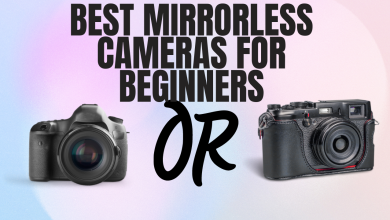Canon EOS R5 vs R6: The Best Mirrorless Camera in 2025?
- The Canon EOS R5 has a higher resolution sensor (45 MP vs. 20.1 MP), better for high-resolution images and large prints, while the EOS R6 is better suited for low-light conditions and action photography due to its higher ISO range and faster continuous shooting.
- Both cameras feature in-body image stabilization, fast autofocus with Dual Pixel CMOS AF II, and high-quality video capabilities, but the R5 supports 8K video whereas the R6 maxes out at 4K.
- The R5 caters to professionals with its superior viewfinder, bigger touchscreen, and advanced connectivity; the R6 offers affordability and robust performance, making it ideal for enthusiasts and professionals focused on speed and low-light prowess.
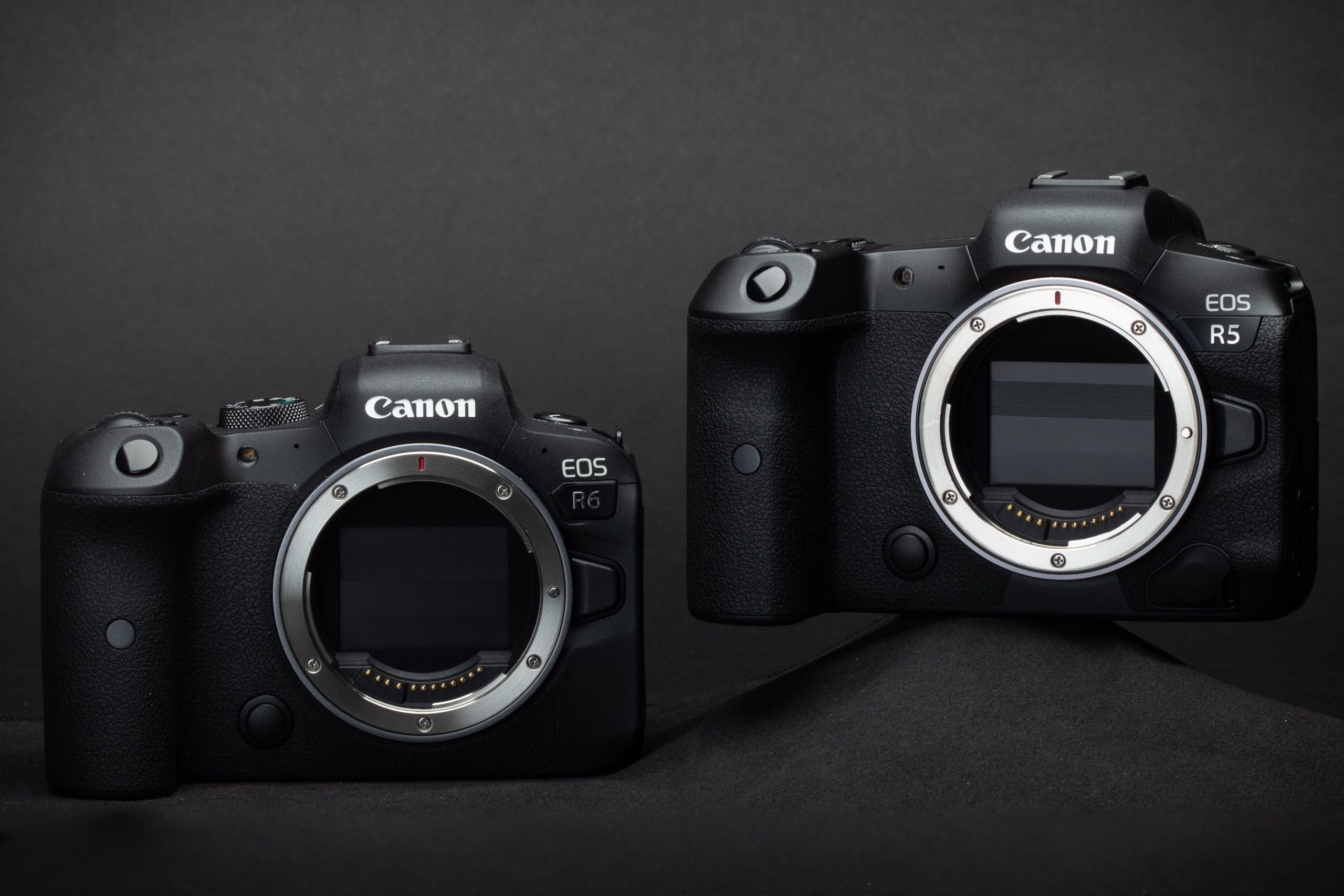
Choosing a suitable camera in this day and age is not an easy task, with mobile phones becoming major contenders in terms of affordable, high-quality photographs and videos. However, high–end mirrorless cameras continue to be the go-to for professionals in the photography and videography sectors owing to their comprehensive feature sets.
Today, we’ll go over the key differences between the EOS R5 and EOS R6, two mirrorless cameras from Cannon’s lineup, so you can make a good choice in purchasing either of these.
Table of Contents
1. Specifications
| Camera Feature | Canon EOS R5 | Canon EOS R6 |
|---|---|---|
| Sensor Resolution | 45.0 MP | 20.1 MP |
| Low-Pass Filter | Yes, High-Resolution OLPF | Yes |
| Sensor Type | CMOS | CMOS |
| In-Body Image Stabilization | Yes, 5-axis | Yes, 5-axis |
| Sensor Size | 36.0 x 24.0mm | 36.0 x 24.0mm |
| Image Size | 8192 x 5464 | 5472 x 3648 |
| Pixel Pitch | 4.40 µm | 6.58 µm |
| Image Processor | DIGIC X | DIGIC X |
| Viewfinder | Electronic / EVF | Electronic / EVF |
| Viewfinder Type / Resolution | OLED / 5.76 Million Dots | OLED / 3.69 Million Dots |
| Viewfinder Coverage | 100% | 100% |
| Viewfinder Magnification | 0.76x | 0.76x |
| Built-in Flash | No | No |
| Flash Sync Speed | 1/200 | 1/200 |
| Storage Media | 1x CFexpress / 1x SD UHS II | 2x SD UHS II |
| Continuous Shooting Speed M / E | 12 FPS / 20 FPS | 12 FPS / 20 FPS |
| Buffer Capacity (RAW) | 87 (SD UHS II), 180 (CFexpress) | 240 (SD UHS II) |
| Max Shutter Speed | 1/8000 | 1/8000 |
| Electronic Front-Curtain Shutter | Yes | Yes |
| Exposure Metering Sensor | 384-Zone Metering | 384-Zone Metering |
| Base ISO | ISO 100 | ISO 100 |
| Native ISO Sensitivity | ISO 100-51,200 | ISO 100-102,400 |
| Autofocus System | Hybrid PDAF | Hybrid PDAF |
| Focus Points | 1053 | 1053 |
| Low—Light Sensitivity | -6 to 20 EV | -6.5 to 20 EV |
| Internal Video Modes | H.264 4:2:0 8-Bit, H.265 4:2:2 10-Bit | H.264 4:2:0 8-Bit, H.265 4:2:2 10-Bit |
| Video Maximum Resolution | 8K DCI @ up to 30p, 4K DCI @ up to 120p | 4K UHD @ up to 60p, 1080p @ up to 120p |
| 4K Video Type | Full-sensor width (oversampled) | 1.07x Crop |
| HDMI Out / C—LOG | 4:2:2 10-bit HDMI Output / Yes | 4:2:2 10-bit HDMI Output / Yes |
| Articulating LCD | Yes | Yes |
| Touchscreen | Yes | Yes |
| LCD Size | 3.2″ Diagonal LCD | 3.0″ Diagonal LCD |
| LCD Resolution | 2,100,000 dots | 1,620,000 dots |
| Built-in GPS | No | No |
| Wi-Fi / Band | 802.11a/ac/b/g/n / 2.4 GHz and 5 Ghz | 802.11b/g/n / 2.4 GHz |
| Bluetooth | Yes, 5.0 | Yes, 4.2 |
| Battery | Canon LP-E6NH/LP-E6N/LP-E6 | Canon LP-E6NH/LP-E6N/LP-E6 |
| Battery Life (CIPA) | 320 shots | 360 shots |
| Weather Sealed Body | Yes | Yes |
| USB Version | Type-C 3.1 Gen 2 | Type-C 3.1 Gen 2 |
| Weight (Camera Body Only) | 1.43 lbs. / 650g (body only) | 1.3 lbs. / 598g (body only) |
| Dimensions | 5.45 x 3.84 x 3.46 in. / 138 x 97.5 x 88.0mm | 5.45 x 3.84 x 3.48 in. / 138 x 97.5 x 88.4mm |
| MSRP | ~$3,899 | ~$2,499 |
READ MORE: 2K vs 4K – Which One Should You Go For? ➜
2. Physical Features and Design
Let’s start the comparison with the first thing you’ll notice about these cameras—how they look and feel.
i. Front View
There are only subtle design differences between the EOS R5 and R6, otherwise they’re pretty identical. Looking at the front views of both cameras, it’s easy to tell that the R6 is slightly more plasticky than the R5, which has much more notable rubber padding. There is a remote port flap on the EOS R5, which is missing on the R6.
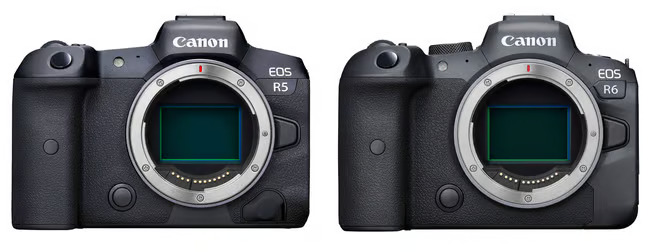
ii. Top View
While the front did not have major differences, the top of both the cameras looks quite different. The two cameras have Canon’s classic top dial with the multi-function button (M-Fn), the EOS R5 boasts a digital top LCD screen that shows all the important data and even includes a button to make the screen more visible in low light.
In contrast, the EOS R6 features a plain rear dial and a conventional PASM dial in the same spot. In reality, the top of the Canon EOS R and EOS R5 cameras seem very similar, therefore Canon decided to keep the original EOS R camera’s working Mode dial on the EOS R5.
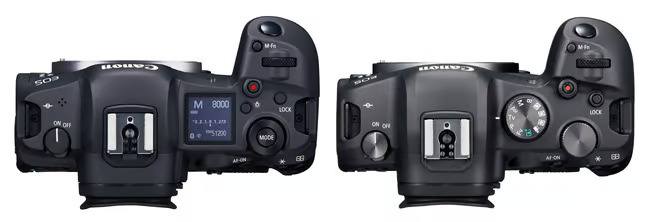
iii. Rear View
The back of both the cameras is completely identical in working except for one thing. The EOS R5 has a larger display compared to that of R6. All of the other features are the same.
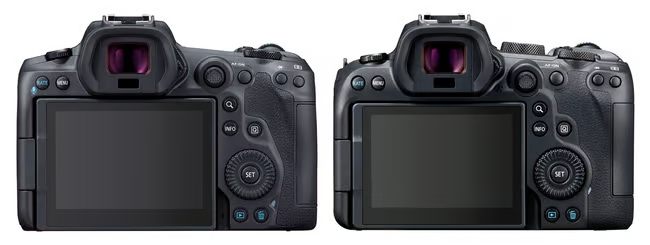
From a practical standpoint, the top LCD screen and the bigger LCD screen on the EOS R5 appear to be the most notable differences between the R6 and the R5. Now we will go over the inner workings of the camera.
3. Image Quality
A DIGIC X Processor, which enhances sharpness, dynamic range, and noise reduction, is included in both of these models resulting in unrivaled professional photographs due to the use of such high technology
Both also come with an in-body image stabilizer that covers five axes and can stabilize the image up to eight stops, allowing you to take great photos handed. One key distinction is the number of megapixels each. When it comes to large landscapes, portraits, street photography, and producing high-quality prints, the 45MP EOS R5 is truly remarkable.
In contrast, the EOS R6 is more suitable for usage in low-light settings with its 20.1MP sensor, which captures more light. Also, when shooting in burst mode, it’s slightly quicker, making it ideal for action and sports photography.
To conclude, both cameras feature cutting-edge technology including image stabilization and rapid processing to ensure clear, well-lit shots with a wide dynamic range. When it comes to landscapes and prints, the EOS R5’s higher megapixel count is ideal, while the EOS R6 excels in low light and shots that require speed.

READ MORE: 1080p vs. 1080i: Understanding The Differences Between Video Resolutions➜
4. Video Quality
Both cameras are quite good at capturing videos of high quality. The EOS R5 is one of the best hybrids available in the market, offering both photography and videography at its finest. The R5 offers 8K video resolution at 30 frames per second, whereas 4K/Full HD Resolution at 120 frames per second. This is the best option for serious filmmakers who value both high-definition video and still images.
Even though the R6 isn’t quite as good as the R5, it still offers 4K Resolution at 60 frames per second and Full HD Resolution at 120 frames per second making it ideal for advanced enthusiasts who like to play around with video. Both cameras have CLog 1 and CLog 3 included for precise color grading and post-production usage.
Lastly, using both cameras gets you top-notch video quality. Picture stabilization and the ability to play around with different levels of dynamic range are just a few of the creative features included with each. With its 8K capability, the EOS R5 surpasses the 4K of the EOS R6.
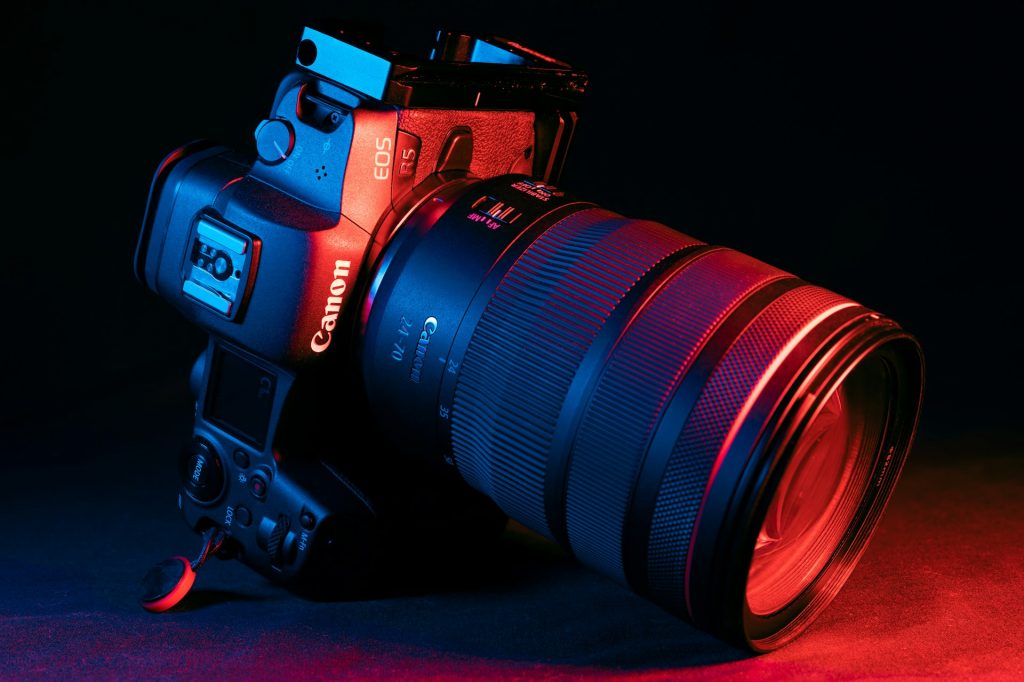
5. Speed
One of the most crucial factors to think about while deciding between the Canon EOS R5 and the EOS R6 is speed.
Although the EOS R6 provides slightly more, both cameras are designed with speed in mind. Both have continuous electrical shooting speeds of 20 frames per second and continuous mechanical shooting speeds of 12 frames per second.
There is a difference in the number of photos. Compared to the EOS R6, whose huge buffer allows it to capture 240 RAW shots and over a thousand JPEGs, the EOS R5’s comparatively smaller buffer can only manage 350 JPEGs. Due to its lower megapixel count, the EOS R6 produces somewhat lower-quality photos.
Rest assured, you will achieve top-notch results and become an expert in sports and action photography. Otherwise, both cameras are fantastic for capturing the unexpected because of their rapid image processing and focusing.
READ MORE: HDMI 2.0 vs HDMI 2.1 – Key Differences & Which is Better? ➜
6. Low Light
For low-light shooting, the EOS R5 and R6 were game-changers. The EOS R5’s ISO range of 100–51,200 and its ability to handle light levels as low as -6EV make it an excellent choice for eliminating noise in your images.
Despite this, it’s hard to beat the EOS R6. You can focus in conditions dimmer than a half-moon with the camera’s -6.5EV capabilities, and the 20.1 MP sensor makes it ideal for low-light situations, resulting in cleaner photographs. Lastly, the EOS R6’s maximum ISO of 102,400 is great for low-light shooting.
To aid in low-light photography without the need for a tripod, both cameras have an in-body 5-axis Image Stabilizer. This stabilizer can reach up to 8 stops when used with a compatible lens.
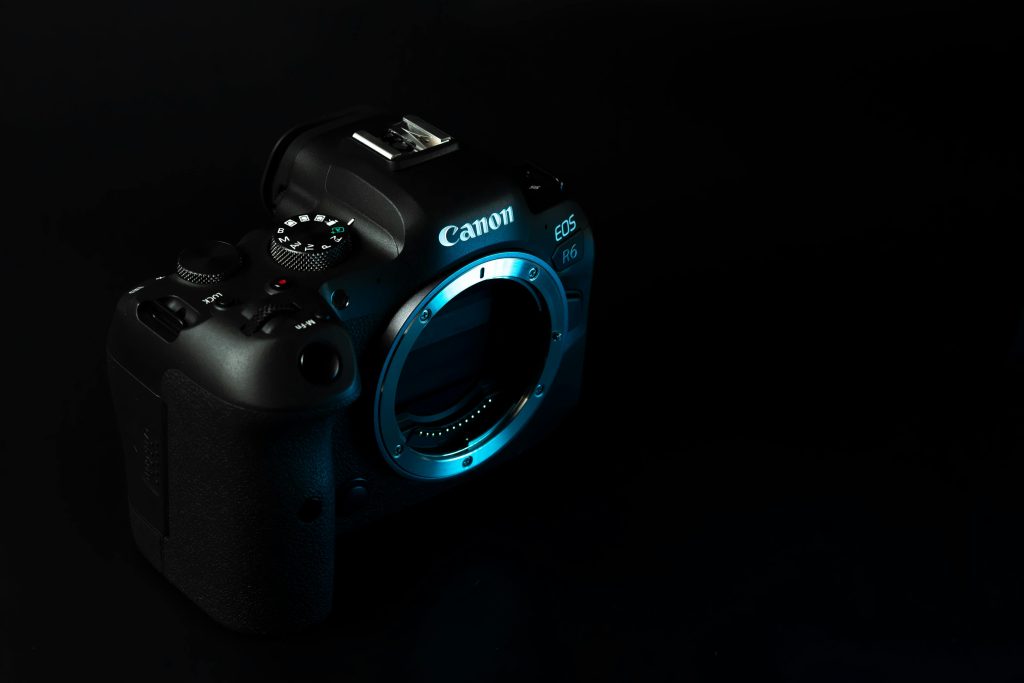
7. Autofocus
For a focusing experience that is both quick and precise, Canon created the Dual Pixel CMOS AF II. You can focus in less than a second without sacrificing image quality because it is built into both cameras.
With 1053 pre-programmed AF positions and 5940 user-selectable AF points, the EOS R5’s AI-based technology can detect, follow, and focus on people (including their eyes, faces, heads, and bodies), animals (including dogs, cats, and birds), and vehicles (including automobiles and bikes).
While recognizing and focusing on the same subjects as the EOS R5, the EOS R6 offers an amazing 6072 customizable positions, covering nearly 100% of the frame. You can focus on people, animals, and automobiles using both cameras’ top-of-the-line deep learning autofocus. The only change is that the EOS R6 has more customizable AF spots around the frame.

READ MORE: How to Fix Blurry Pictures on iPhone in 5 Different Ways ➜
8. Usability
The final point which is one of the most important ones when choosing a camera is how easy it is to use. The built-in capabilities of both cameras are meant to enhance your creative output and overall experience.
The EOS R5 and R6 are exceptionally compact cameras; the former weighs 738 grams and the latter 680 grams. A larger touchscreen and an additional control on the top panel contribute to the EOS R5’s slightly higher weight. One CFexpress card slot and one SD card slot are available on the EOS R5, however, two SD card slots are available on the EOS R6.
For extended periods of photographing when you’re away from home, this makes both of them quite helpful. The LP-E6NH battery is used by both cameras; the EOS R6 can take 510 photos on a single charge, while the EOS R5 can take 490.
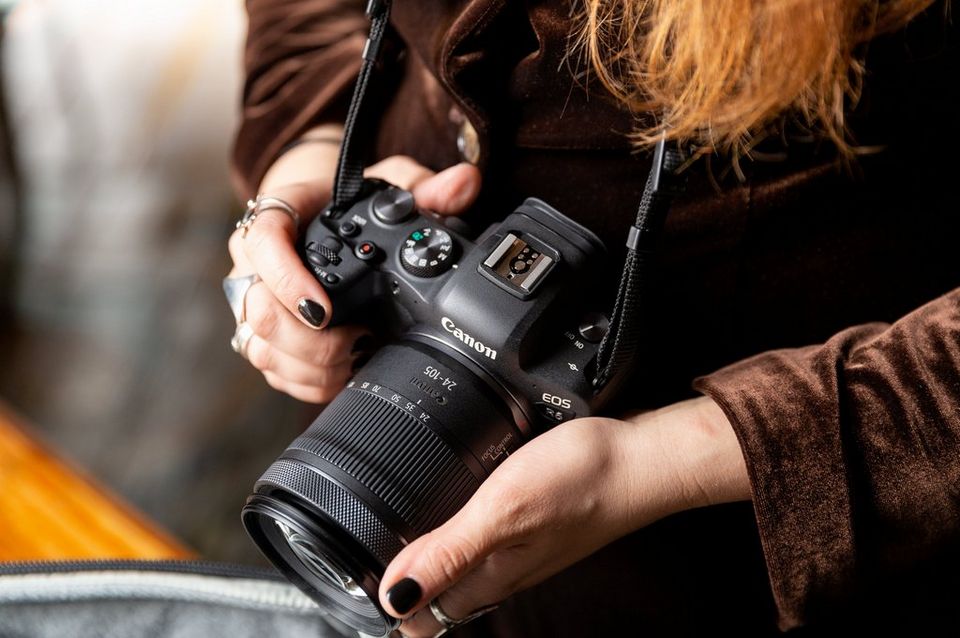
9. Lens Compatability
Choosing a lens is critical for capturing high-quality photographs of any type. It is usually determined by the location, light, and distance of the camera from the subject.
The Canon EOS R5 and R6 both use the same Canon RF Mount and have the same number of available lenses (43).
While the R5 has a better sensor (45Mp vs. 20.1Mp), the R6’s reduced pixel density allows for better diffraction limits and low light performance, though these differences are apparent on paper they seem to be minor depending on your use case. Henceforth the choice of lens depends solely on your use case after you’ve chosen the camera you want.
Aside from sensor quality differences, the quality of a photo is heavily influenced by the lens used. This is why, when you’ve decided on a camera, you should consider your usage and choose a specific lens for the work at hand.

READ MORE: H.264 vs. H.265 – Comparing The Common Video Codecs in 2025 ➜
Conclusion
Additional benefits are available with the Canon EOS R5. In comparison to the EOS R6, it boasts a higher-resolution OLED electronic viewfinder with 5.76 million dots and a bigger 3.2-inch LCD screen. It also makes use of upgraded Wi-Fi and Bluetooth processing units, which come with dual-band capabilities (2.4 GHz and 5 GHz) and Bluetooth 5.0. Only Wi-Fi and Bluetooth 4.2 at 2.4 GHz are compatible with the EOS R6.
Both the Canon mirrorless EOS R5 and the EOS R6 have all the features you might want for professional photography, so it’s hard to choose between the two.
Every day, wedding, portrait, and street photographers and videographers will find all they need with the EOS R5. With its 45 MP full-frame sensor, 8K video, additional controls, and larger touchscreen, you can finally put your skills to use in producing high-quality footage. Anyone with a passion for photography who wants to take their hobby to the next level should consider the EOS R6.
Its lower megapixels, higher ISO, and higher EV value make it suitable for use in low light, and its ability to deliver more photographs in continuous burst mode than the EOS R5 makes it well-suited to sports and action.
Rest assured, AI-based autofocus, 5-axis in-body IS (up to 8 with the correct lens), and a DIGIC X Image Processor ensures lightning-fast image processing regardless of the camera you choose. Go out there and shoot with what suits you best.
 Reviewed by
Reviewed by 